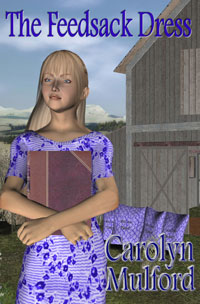- The Feedsack Dress
- Ordering Information
- The Historical Background
- Chapter One: The Feedsack Dress
- Discussion Topics for Book Groups
- Discussion Topics for Students
- Blog: The Feedsack Kids
 The Feedsack Dress
The Feedsack Dress
by Carolyn Mulford
Cave Hollow Press, 2007,
228 pp., $7.95
ISBN: 978-0-9713497-4-2.
When Gail wears a pretty feedsack dress the first day of ninth grade in 1949, the mean queen makes nasty comments about poor country kids. Every time Gail wears her homemade dress, something awful happens. Her refusal to buckle and her defense of the mean queen’s other targets earn Gail an unwanted honor, leader of a revolt against the ruling clique.
The Missouri State Teachers Association selected The Feedsack Dress for the state’s Reading Circle Program for grades five to eight in 2008. The book also appeals to readers who lived in rural areas in the mid-twentieth century and used the colorful patterned sacks to make clothing and other household items.
The Missouri Center for the Book selected The Feedsack Dress as the state’s Great Read at the 2009 National Book Festival in Washington, D.C.
![]() Ordering Information
Ordering Information
Print Edition: www.cavehollowpress.com Amazon
Nook: Barnes and Noble
On the frontier, people used any cloth available, including the bags that contained such products as flour and sugar, to make clothing and such household items as curtains and quilts. Women often dyed the plain cotton sacks with homemade or commercial products.
In the early 20th century, companies competed for customers by placing their products, especially chicken feed and flour, in cotton bags imprinted with pretty patterns. Companies printed their names with ink that buyers could wash out. The Midwest and South were the centers for the pretty sacks, but farmers all over the country bought feed in them. Many city folks bought flour in them.
In those days most women sewed both by hand and on a sewing machine. They made their own clothing or, if they had enough money, hired seamstresses or tailors to do it.
During the Depression and World War II, farmers and townspeople valued the sturdy, colorful cloth for making clothing and household items. Women bought paper patterns to guide them in cutting out and sewing the latest styles in dresses, blouses, and skirts.
Many farm children and their city cousins wore clothing made from feedsacks. A little girl’s skirt or a little boy’s shirt required only one feedsack. An adolescent usually needed two feedsacks for a dress. A grown woman generally had to find three feedsacks of the same pattern to make a dress.
In the post-war prosperity, synthetic cloths became abundant, fewer farmers raised chickens, and many more people could afford ready-made clothing. In the Midwest and the South homemade feedsack clothing lived on for years.
Today quilting stores offer reproductions of some of the most popular of the hundreds of patterns once available.Quilters and collectors treasure the humble feedsacks.
Chapter One: The Feedsack Dress
Discussion Topics for Book Groups
Discussion Topics for Students
![]() Blog: The Feedsack Kids
Blog: The Feedsack Kids
In The Feedsack Dress, set in northeast Missouri in 1949, the mean queen makes fun of students who transfer from one-room rural schools to the town’s junior high by calling them the feedsack kids.
Most of the posts derive from my memories of or research on farm life in the mid-twentieth century. I was one of many farm girls wearing feedsack dresses and blouses. I learned to sew making feedsack tea towels, aprons, potholders, and shorts. My mother made me sew, but she always gave me a vote in choosing the sacks. They were pretty. Really. Read more.
